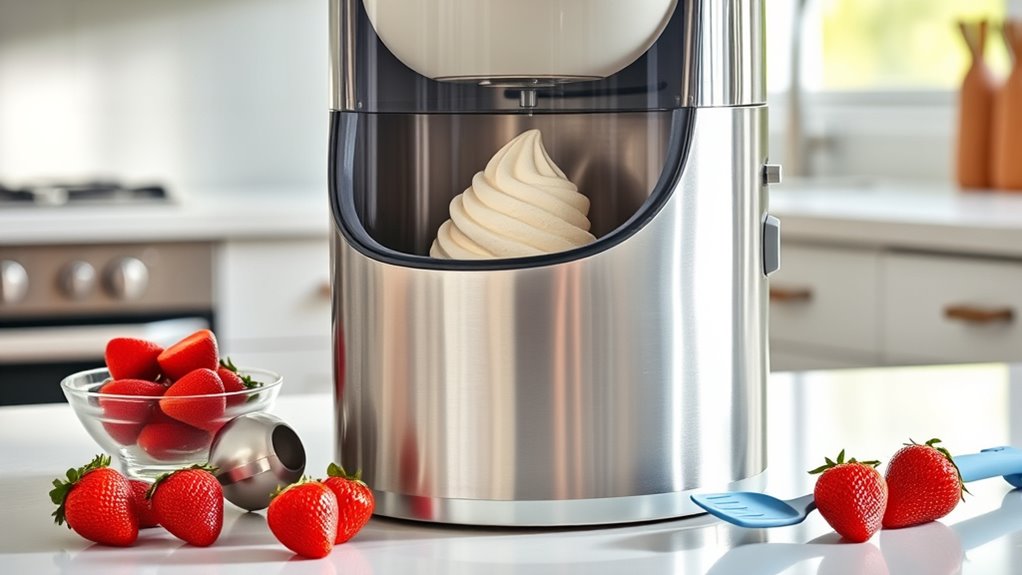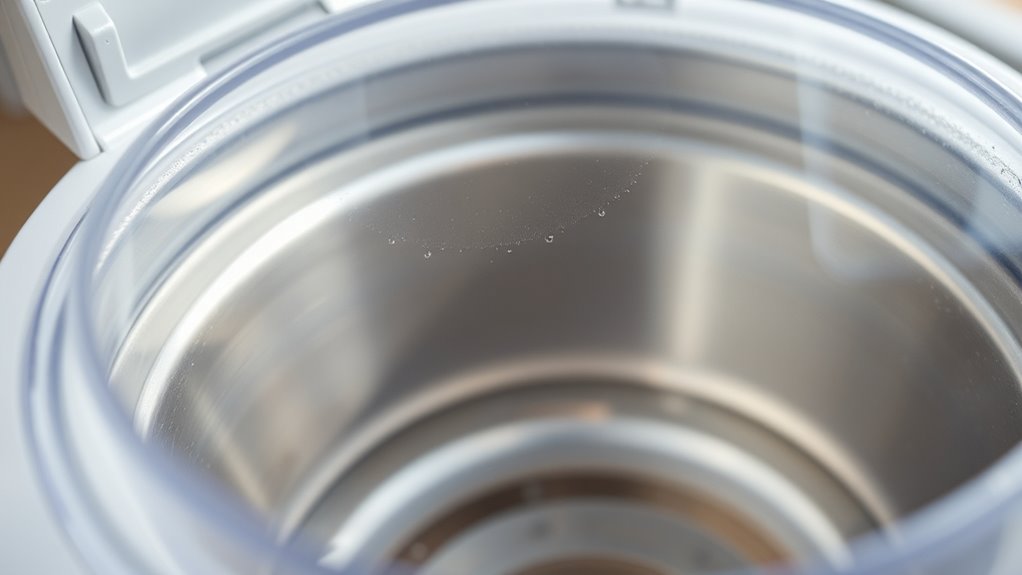To guarantee your ice cream maker is safe, regularly clean all removable parts with warm, soapy water and dry them thoroughly. Check for damaged cords or parts, and never immerse the motor or electrical components in water. Always use the appliance on a grounded outlet and unplug it before maintenance. Keep safety features engaged and follow the manufacturer’s instructions carefully. Staying vigilant helps prevent accidents and extends your machine’s life—continue to find out more to keep it operating safely.
Key Takeaways
- Regularly clean all removable parts with warm, soapy water and dry thoroughly to prevent bacterial growth.
- Inspect electrical cords and safety features regularly, replacing damaged parts promptly.
- Unplug the unit before cleaning or maintenance, and never immerse the motor base in water.
- Ensure the appliance is used on a properly grounded outlet and avoid overloading power sources.
- Follow manufacturer guidelines for routine maintenance and safety checks to ensure safe operation.

Have you ever thought about the safety risks involved when using an ice cream maker? Many people focus on the delicious treats they can make, but neglect the essential safety steps that keep you safe during operation. One of the most important aspects is following proper cleaning protocols. After each use, you should thoroughly clean all removable parts, including the mixing bowl, paddle, and lid, with warm, soapy water. Bacteria can quickly develop if food residue or milk splatters are left behind, which could lead to foodborne illness. Make sure to dry all parts completely before reassembling to prevent mold or bacterial growth. Additionally, avoid using abrasive scrubbers that might damage the equipment or create tiny cracks where bacteria can hide. Regular cleaning not only guarantees food safety but also prolongs the lifespan of your ice cream maker. Proper maintenance also includes inspecting the projected lifespan of your appliance, which can help you identify when replacement parts or upgrades are necessary. Regularly consulting the product manual can provide valuable insights into specific maintenance routines recommended by the manufacturer. Staying informed about appliance safety features can help you better understand how your device is protected against hazards. Conducting routine safety checks can further prevent potential accidents associated with electrical or mechanical faults. Electrical safety is another vital factor that you shouldn’t overlook. Since most ice cream makers operate with an electric motor, you need to stay vigilant about how you handle the appliance. Always plug the machine into a properly grounded outlet to prevent electrical shocks. Before cleaning or performing maintenance, unplug the device to avoid accidental activation. Never immerse the motor base or electrical components in water—only the removable parts should be washed with water. When cleaning, check the power cord for any signs of damage or fraying. If you notice issues with the cord or plug, stop using the machine until it’s repaired or replaced to avoid electrical hazards. Keep the cord away from hot surfaces and water to prevent short circuits. Also, make sure the electrical outlet is in good condition and that the plug fits securely, reducing the risk of sparks or electrical fires. Being mindful of electrical safety also means avoiding overloading outlets or using extension cords that aren’t rated for the appliance’s power needs. Always adhere to the manufacturer’s instructions regarding electrical specifications, and don’t attempt to modify or bypass safety features. Remember, a little extra caution during cleaning and handling can prevent serious accidents. By maintaining proper cleaning protocols and practicing electrical safety measures, you keep yourself protected and ensure your ice cream maker operates smoothly for years to come. Staying vigilant about these safety details isn’t just about protecting your health—it’s about enjoying your favorite frozen treats safely and confidently every time you make ice cream.
Frequently Asked Questions
Can I Use Homemade Ice Cream Recipes in All Machines?
You can’t use all homemade ice cream recipes in every machine without verifying compatibility. Different machines have unique requirements, so some recipes might need specific churning speeds or ingredients. Always read your user manual to guarantee your recipe matches your machine’s compatibility. If a homemade recipe isn’t designed for your appliance, it might not churn properly or could damage your machine. Stick to compatible recipes for the best results.
Are There Specific Cleaning Tips for Different Ice Cream Maker Models?
They say “an ounce of prevention is worth a pound of cure,” and that’s true for cleaning your ice cream maker. You should follow model-specific maintenance and cleaning protocols to keep it in top shape. Check your user manual for detailed instructions, as different models may require different cleaning tips. Regular cleaning guarantees your machine runs smoothly and produces delicious ice cream every time.
How Long Does an Ice Cream Maker Typically Last?
Your ice cream maker’s durability lifespan varies, but with proper maintenance, it can last 5-10 years. Regularly following the maintenance schedule, like cleaning parts thoroughly and checking for wear, helps extend its life. Pay attention to the manufacturer’s recommendations, and avoid overusing or mishandling it. Proper care guarantees your machine remains efficient and safe, giving you delicious ice cream for years to come.
Is It Safe to Leave My Ice Cream Maker Plugged In?
You should avoid leaving your ice cream maker plugged in when not in use to guarantee electrical safety. Constant power can lead to overheating or electrical issues, risking damage or fire hazards. Proper appliance maintenance includes unplugging your device after use and inspecting cords regularly. By following these safety tips, you protect yourself and prolong your ice cream maker’s lifespan, ensuring it remains safe and functional for years to come.
What Are Common Signs of a Malfunctioning Ice Cream Maker?
Your ice cream maker might be warning you with signs of malfunctioning. If you notice the machine overheating or hear strange noises, don’t ignore it—these are major red flags. Overheating could cause a fire, and strange sounds often mean parts are misaligned or broken. Always stop using it immediately if you see these signs, and troubleshoot or replace the unit to keep your kitchen safe and your treats perfect.
Conclusion
If you ignore these safety tips, your ice cream maker could turn into a ticking time bomb, releasing chaos in your kitchen! Don’t risk melting down your entire dessert dreams over a simple mistake. By staying vigilant and following these precautions, you’ll keep your ice cream maker safe and your treats perfectly frozen. Trust me, a little caution now saves a mountain of mess—and maybe even your sanity—later. Stay safe, and enjoy your sweet, worry-free ice cream adventure!










